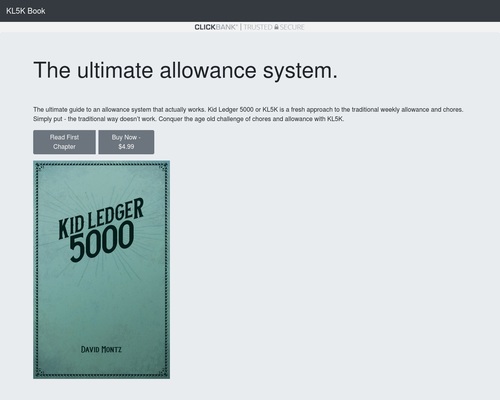As I handed my 9-year-old 60 bucks, I got a question from his younger brother, Ben.
“Dad, why is Andrew getting all of that money?”
“He’s using his ledger money,” I explained. “Andrew earned this money.”
A few days earlier, Andrew had also invested $250 in a trading account. Did I mention he paid for it with his own money? Money he could have used to buy toys or junk food? Instead, he bought a stock that will continue to compound until he becomes an adult.
How did my 9-year-old earn that kind of dough? What led him to want to spend his money on something as boring as stocks? The answer is…….a simple ledger system. We tweaked and tuned the parts as we went along. Dropping what didn’t work and tuning what did. This book outlines the system we eventually created: Kid Ledger 5000, or KL5K. It is a system that outlines how to get your kids interested in and successfully using a budget, generating income, doing chores, providing for themselves and actually helping Mom and Dad.
Included in this book are step-by-step instructions, printable artifacts, troubleshooting tips, advanced strategies, and more. KL5K isn’t your typical chore chart or weekly allowance plan. We tried the tradition techniques and they just didn’t work. KL5K is unique in its approach and I am convinced it can help other families just like yours.
KL5K is part intuitive description, and part fun. I’ve always said you can add fun to just about any name if you add 5000 to it: Blender 5000, Gadget 5000, Fidget Spinner 5000. More fun, right? KL5K is a system that teaches you to how to get your kids interested in and successfully using a budget, generating income, doing chores, providing for themselves, and helping Mom and Dad in the process. It provides step-by-step instructions on what to do, how to do it, when to do it, and lessons learned so that you have the best chance of success. KL5K is a repeatable process, and it works regardless of how many children you have.
When KL5K is successful, both parent and child feel as though they got the better end of the deal. And isn’t this the ideal result of all transactions, whether in life or in business? Why have any other expectations with your kids?
To generate a win-win, you have to create an exchange of value between two parties. The parents might define value as things like a clean kitchen, empty garbage cans, a weed-free yard, an hour of babysitting. Kids typically define value as the ability to buy things. This isn’t the only way to define what kids find valuable, of course, but it is a pretty darn good one.
The goal of win-win is to define things that actually help the parents, creating value on one side of the equation. In exchange, the parents define value for the other side of the equation, 10 cents or 50 cents or whatever amount, in exchange for a job well done. Simple, right? Kid does the job and gets paid: win. Mom and Dad have less work to do in the day: win. After the work is complete, your child now has his first ledger entry! Or more specifically, words and numbers written on a piece of paper.
But wait! That doesn’t sound like a fair trade to the child, right?
For the benefit to be realized by both parties, there needs to be a reliable and consistent way in which value can be realized. For the parent, this is easy: Clean the dishwasher or empty the garbage can. For the child, it’s a bit more complicated at first. They need to connect the dots. It is critical for them to understand that the words on the paper mean something significant. They need to understand that it is effectively the equivalent of having real money in their pocket. They need to be able to spend to realize the value. The lightbulb truly starts to flicker on the first time Mom and Dad let them spend their hard-earned ledger money, with lots of praise and encouragement, on anything they want.











